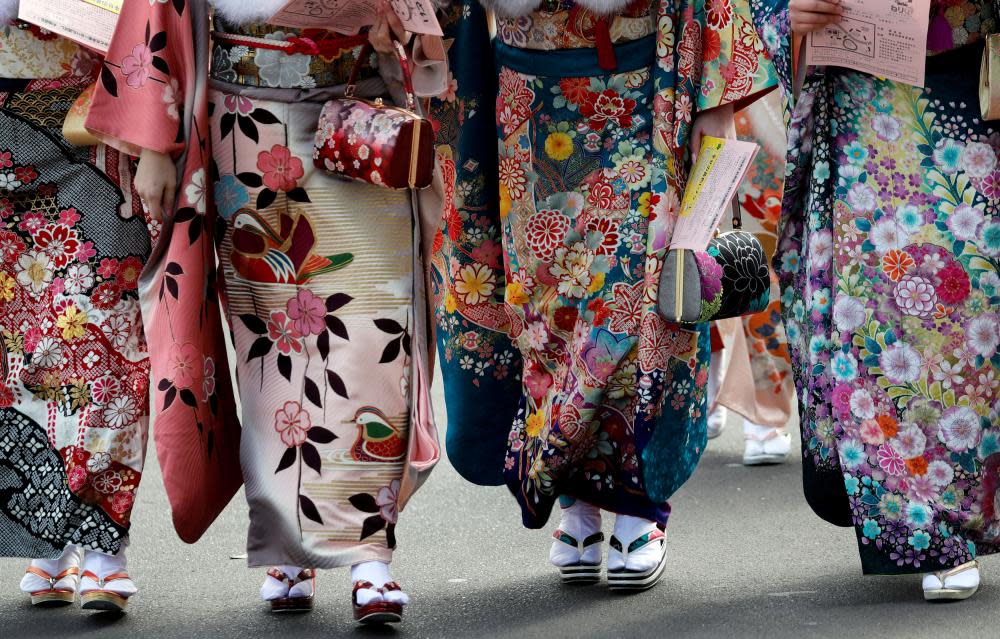Asian women and the kimono have long been sexualized in western culture

The two Asian women painted on the facade of the Irish pub outside the US military base in Okinawa, Japan, wore kimono. They lounged on a white-sand beach. Their black hair was coiled atop their heads, and their garments were falling open to reveal bare legs and cleavage.
Related: Kim Kardashian West’s Kimono shapewear touches nerve in Japan
Never mind that the real women in that area didn’t dress like that. Instead of kimono and up-dos they sported colored contacts, blonde hair extensions, fake tans and jeans. Never mind that kimono are ankle-length and high-necked, covered-up. To the artist or bar owner, the picture that would draw men inside, the epitome of desire, was the woman in the kimono – and an erotic style of kimono that doesn’t exist.
It’s no surprise that Kim Kardashian West appropriated kimono to sell underwear. In the western imagination, Asian women have long been sexualized, and an emblem of the Asian woman is the iconic Japanese gown.
When American troops invaded Okinawa in April 1945, the specter of the sexualized Asian woman already existed. “The pigs and chickens are okay,” one marine told a Chicago Daily Tribune reporter, shortly after the American landing, “but I’m disappointed in the girls. They’re not what they told me.” Implying a surprised disgust, the reporter goes on to describe local women bathing and washing their clothes in a roadside trough.
These were women caught between opposing forces on a battlefield, tasked with fighting for their lives amid a “typhoon of steel”. And yet these American invaders saw them only in sexual terms, evaluated alongside livestock.
This viewpoint continued in the aftermath of the battle, when Okinawan survivors were traumatized and destitute. “Hubba! Hubba!” reads a caption in a US military souvenir booklet produced just after the war. The photo is of an Okinawan woman dressed in worn clothes and sandals, her baby strapped to her back.
In Japan, the kimono are formal wear and connote not sex, but tradition and elegance
Maybe Kardashian West’s attempt to name her shapewear line Kimono was a marketing stunt – with the backlash, how many of us have now seen her nude bodysuits – or maybe the word seemed to offer up the exoticism, the sex appeal, she was looking for.
In Japan, the kimono means something very different than in the west. In the country today, kimono are formal wear. Often made of silk and costing upwards of a thousand dollars, a kimono is attire for a wedding, a graduation or other special occasion. It connotes not sex, but tradition and elegance.
Upon hearing this cultural treasure was being used to shill American underwear, Japanese citizens reacted with anger. The mayor of Kyoto weighed in, penning a letter to Kardashian West asking her to reconsider her Kimono trademark. The city, he reported, was undertaking its own efforts to register “Kimono Culture” to Unesco’s Intangible Cultural Heritage list. (Kardashian West had reportedly trademarked names like “Kimono World”.) The kimono, Mayor Daisaku Kadokawa wrote, “truly symbolizes [the] sense of beauty, spirits and values of Japanese”.
Japanese Americans also joined the #KimOhNo outcry, but for those of us of Japanese heritage in the States, the kimono can have a more complicated symbolism. My own relationship to the style of clothing began as a toddler, when my mother first dressed me up in a mini kimono-like garment. When I was in third grade, my great-grandmother, who had immigrated to the United States from Hiroshima, visited my school to demonstrate the tricky process of putting a kimono on.
Years later, studying abroad in Kyoto in college, my first time to Japan, I tried on an authentic kimono myself, when my classmates and I rented them for a day. “It looks better if your geta are too small,” the Japanese woman dressing me said. Wearing too-small shoes was just one way the kimono-wearing experience was physically restrictive. In the tight column of fabric, I tottered around the city’s historic streets.
America has already rewritten the story of the kimono
To the tourists who snapped photos of me that day, I may have looked like a traditional Japanese woman, a titillating figure straight from the pages of Memoirs of a Geisha. But I knew to the natives of the city even the classic Japanese gown wouldn’t cause them to see past my mixed-race face and American ways. Even wearing a kimono, I wasn’t truly Japanese.
The Japanese American artist Judy Shintani has a series called Deconstructed Kimonos. Shintani transforms kimono by cutting away patterns in the fabric, reducing them to shreds.
“My alterations reflect the loosening connection to my ancestry and culture,” she writes, and she evokes the intense pressure Japanese Americans felt to assimilate during the second world war. After Pearl Harbor, her family and many others, including mine, made bonfires out of anything deemed Japanese. Into the flames went Japanese scrolls, books and kimono.
As a symbol of Japanese American culture, Shintani’s shredded kimono feels fitting. Ravaged by a life in America, it, as Shintani writes, “is reduced to a skeleton, a web” – yet still retains the outlines of its original form.
This is what America has done to the kimono. Kardashian West may have announced her intention to rename her brand, but the story of the kimono here has already been rewritten.
Still, just the other day, a Japanese American friend gifted me a bright pink, tiny jinbei for my infant daughter. A mixed-race, fifth-generation Japanese American, my daughter will wear the cotton, kimono-like onesie to a summer obon festival. I imagine that, years from now, she can look back at a photo of herself in it and decide what the garment means to her.
Akemi Johnson is the author of Night in the American Village: Women in the Shadow of the U.S. Military Bases in Okinawa.

